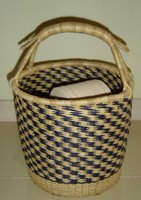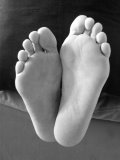Arts and Crafts
We have been busy doing our part to add to the Ghanaian economy, visiting the Arts and Crafts areas around town (there are two biggies- one near our house at the bottom of the hill and one near the Ocean plus loads of roadside vendors with everything from furniture to baskets to cloth), and making sure we acquire the things that will always remind us of our time here.
The people who run booths at the Arts Markets are hilarious. As you wander around in your Obroni skin (which marks you instantly as someone with disposable income and cash in your pocket) they welcome you and remind you that "It's free to look." Once you start to look, of course, you are told in a serious and sincere voice that you are guaranteed a "small price" for whatever you might choose.
If you stop to look at anything for more than 1/2 a second, it is immediately swooped up and put in better light for you to look at.
If you actually touch something, you are immediately shown five similar items that might also interest you.
If you really like it, you have to ask how much. The price given will be at least double what the vendor hopes to get (This only counts for 'things'- prices for food are firm).
At this point you are supposed to begin bargaining for your item.
Except we suck at bargaining.
We hate bargaining.
It just isn't in our nature to bargain, especially with people whose annual income is roughly what we spend on gasoline in a month. But to a Ghanaian, bargaining is culturally ingrained- they do it with each other for everything from taxis to house rentals. The idea of a fixed price for an item, service, or real estate seems foolish to them. So when in Africa, do as the Africans do...
We have developed a system- we figure out in our heads how much an item is worth to us (sometimes that involves picturing it at Pier One and knowing they would ask X amount of money for it, sometimes it's just falling in love with a piece and being willing to spend X dollars on it).
Then we do superfast math in our heads to convert their asking price to our "what's it worth" price then do superfast reverse math to put it back in local currency and make a counter offer somewhat below our top price. We never stand around and haggle- it's offer/counteroffer/countercounteroffer and then we usually give up. About 30% of the time they will follow us with a better offer, but we are so proud of them when they just let us walk away- we almost prefer the kiss off. It's more dignified for everyone. ;-)
Anyhoo, we have acquired some really interesting stuff. What follows is a Ghanaian Arts and Crafts Primer. If you are lucky enough to be family members, make note of what you like and we will make sure we bring you your very own stuff when we return to the U.S. (call them very very late Christmas gifts...)

First up:
These are oversized combs with carvings at the top. There are all sorts of images and wood types and they vary in size from about six inches to three feet tall.
 This is one of many animals available- in all sizes and all colors of wood. Hippos, turtles, elephants, giraffes, you name it, they got it.
This is one of many animals available- in all sizes and all colors of wood. Hippos, turtles, elephants, giraffes, you name it, they got it. The human form is available in different poses, usually in this dark wood, in almost any size from 4 inches to a foot or more.
The human form is available in different poses, usually in this dark wood, in almost any size from 4 inches to a foot or more. This is one of our favorite masks. These stripey ones are common- they just tickle us. It's wooden.
This is one of our favorite masks. These stripey ones are common- they just tickle us. It's wooden.
Baskets! We have baskets! Omigod, do we have baskets. They are tightly woven, very well made and come in every color you can think of (hot pink being a favorite!). They are made round like this, or oval, one handle or two- rarely no handles. Sized about a foot across to about two feet across. All handmade, all done right here in Accra.

This little chest of drawers is handmade of wood and woven grass. We got it for $35 U.S.! And no, I won't buy you one. My shipping container is only so big. :-P
 This is a wooden bowl. Most of the ones we've seen are fancier (have handles or extra carvings on them) but we really liked this one for its simplicity. It's about 18 inches across the top, carved out of a single piece of wood.
This is a wooden bowl. Most of the ones we've seen are fancier (have handles or extra carvings on them) but we really liked this one for its simplicity. It's about 18 inches across the top, carved out of a single piece of wood.
These little guys are carved wood and intertwined- they can be folded up flat or used to display anything that will rest on their heads. You can get these in light or dark wood. This is the smallest size and they get much much bigger- enough to hold a world globe or table top. We also bought the basket it sits on- $15 U.S.
 Cooper assisted me here to show scale. These are masks with faces we couldn't resist. Unfortunately, I can't get enough of them in a picture to show the detail, so you'll have to take my word for it. There are faces there, and lots of intricate carving.
Cooper assisted me here to show scale. These are masks with faces we couldn't resist. Unfortunately, I can't get enough of them in a picture to show the detail, so you'll have to take my word for it. There are faces there, and lots of intricate carving.  This mask is an all time favorite. It's fairly old, made of wood, and hangs in the living room.
This mask is an all time favorite. It's fairly old, made of wood, and hangs in the living room. These are leather boxes. The big one is about four inches across and the lids fit into a rim on the base.
These are leather boxes. The big one is about four inches across and the lids fit into a rim on the base.
I love this bracelet. This is the one I wear most. It's made of some kind of grassy/string type material and it just looks gorgeous on my arm. Cost me two bucks.
 These are very typical of the beaded bracelets you can get here- all colors and patterns and shapes. One circle or two (these are two different bracelets of two circles each). You can buy the beads loose, you can buy matching necklaces and earrings, you can get them all very very cheaply. These two together cost me three bucks.
These are very typical of the beaded bracelets you can get here- all colors and patterns and shapes. One circle or two (these are two different bracelets of two circles each). You can buy the beads loose, you can buy matching necklaces and earrings, you can get them all very very cheaply. These two together cost me three bucks. This is a leather box with a hinged lid. It's big enough to hold legal sized papers. These are each made individually and it's hard to find two the same color/size/decoration. We overpaid for this because we liked it so much- about thirty bucks.
This is a leather box with a hinged lid. It's big enough to hold legal sized papers. These are each made individually and it's hard to find two the same color/size/decoration. We overpaid for this because we liked it so much- about thirty bucks.That's a beginner's guide to some of the gorgeous stuff they sell around here and that is considered ordinary. Our Ghanaian friends are aghast when we tell them that very few Americans can make things like this and the ones who do get premium prices for their effort because it's so unusual.
When I learn more about the native cloth (Kente cloth) and take that plunge, I'll give you the poop on that, too. It's everywhere and made on looms by the roadside- in the mornings you can see the guys setting up rocks on the far end of thirty or more feet of weaving thread getting ready to start at the hand loom...








<< Home